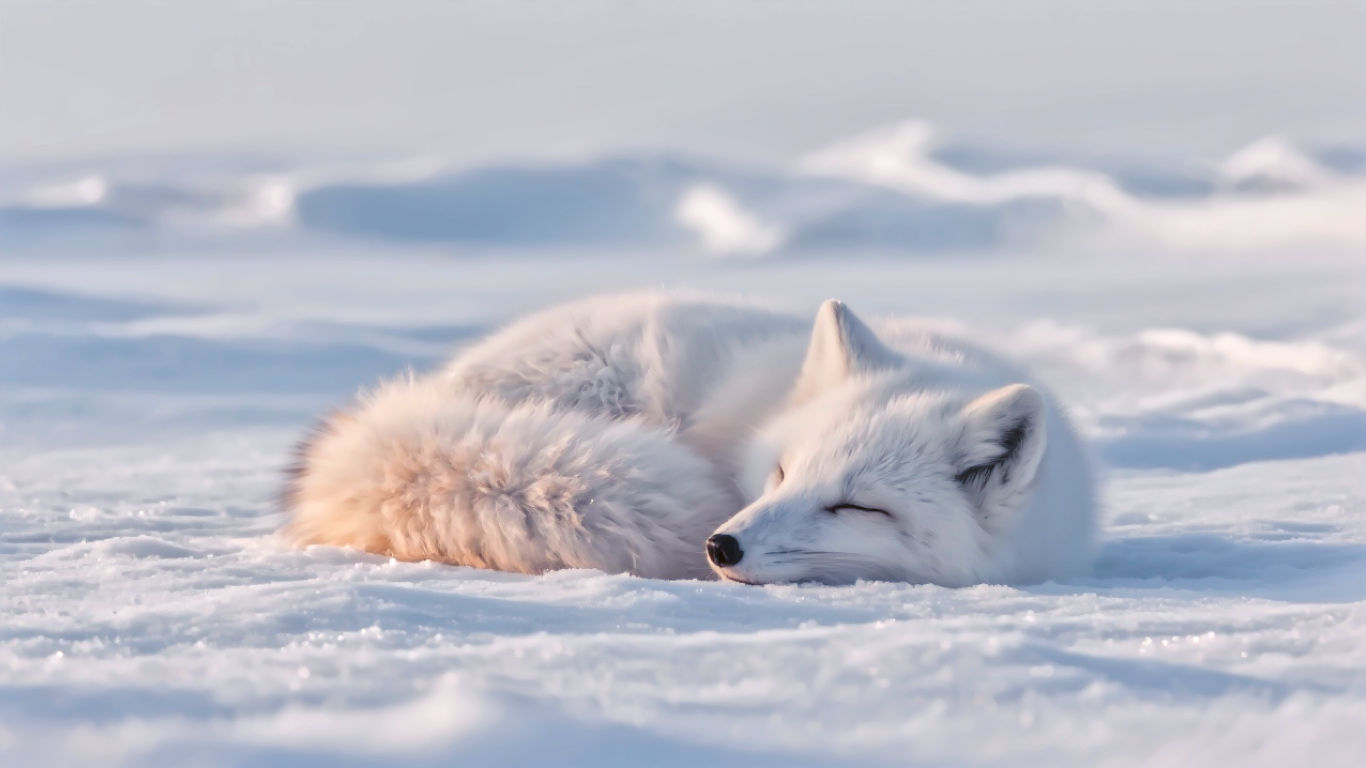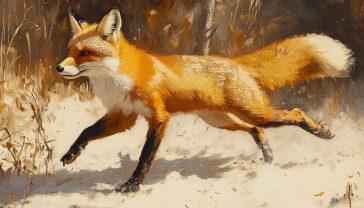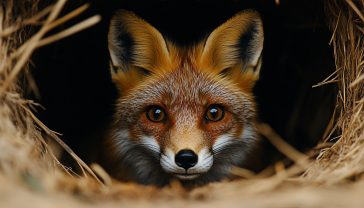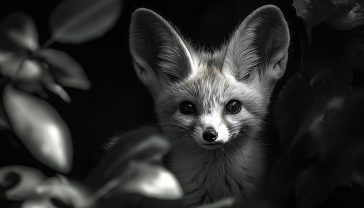The Ultimate Survivor: Where Do Arctic Foxes Live and How Do They Master the Ice?
Where do Arctic foxes live? This guide explores their vast Arctic habitat, from the tundra to sea ice, and reveals how they survive the cold.

This post may contain affiliate links. If you make a purchase through these links, we may earn a commission at no additional cost to you.
Imagine a world of brilliant white, a vast, frozen desert stretching as far as the eye can see. The wind howls, a relentless, biting force that can freeze skin in minutes. It’s a place where temperatures plummet to a bone-chilling -50°C. To us, it sounds like an impossible place to live. But for one small, resilient creature, this is home. This is the world of the Arctic fox.
These incredible animals aren’t just surviving in one of the planet’s most extreme environments; they’re thriving. They are masters of the cold, perfectly equipped for a life lived on the edge of the world. But where exactly is this edge? When we ask, “Where do Arctic foxes live?,” the answer isn’t just a simple spot on a map. It’s a story of immense, sprawling landscapes, of ice and snow, and of a creature built to conquer the cold.
This guide will take you on a journey into the heart of the Arctic fox’s kingdom. We’ll explore the vast, treeless plains of the tundra, follow them onto the shifting sea ice, and peek inside their complex underground dens. We’ll uncover how they change their coats with the seasons, how they hunt when food is buried under feet of snow, and why their future is deeply connected to the health of our planet. So, wrap up warm and let’s step into the frozen world of this ultimate Arctic survivor.
The Arctic Fox’s Global Kingdom: A Ring Around the Top of the World
So, where on Earth do you find these hardy little animals? The simple answer is: all over the Arctic. The Arctic fox has what’s called a circumpolar distribution, which is a fancy way of saying they live in a massive ring that circles the North Pole.
Think of a map of the world. The Arctic fox’s territory covers the icy lands of northern North America, Greenland, Iceland, Scandinavia, and Siberia in Russia. They are the only native land mammal in Iceland, which tells you just how tough you have to be to make a living there!
Their home isn’t one single type of place. It’s a vast, varied, and incredibly challenging environment. We can break it down into a few key areas.
The Tundra: The Fox’s Main Home
The primary habitat for the Arctic fox is the Arctic tundra. This is the classic landscape you probably picture when you think of the Arctic: a huge, treeless expanse that’s frozen for most of the year.
- What is the Tundra? The word “tundra” comes from a Finnish word meaning “treeless plain.” It’s defined by something called permafrost—a layer of soil, gravel, and sand that stays frozen solid all year round. In the short summer, only the top layer of soil thaws out, creating boggy ground and shallow pools. No deep-rooted trees can grow here, only low-lying plants like mosses, lichens, sedges, and small shrubs.
- Why is it Perfect for Foxes? This seemingly bleak landscape is actually ideal for Arctic foxes. The low-growing vegetation provides cover from predators like golden eagles and polar bears. More importantly, it’s home to their favourite food: lemmings and voles. These small rodents burrow under the snow in winter and scurry through the plant life in summer, providing a crucial food source for the foxes and their pups. The slightly softer ground in summer also allows the foxes to dig their extensive dens.
You’ll find Arctic foxes across all the world’s major tundra regions, from the Canadian Arctic Archipelago to the vast, windswept plains of Siberia.
Beyond the Plains: Coastal and Mountain Life
While the open tundra is their main stomping ground, Arctic foxes are incredibly adaptable. Their territory often extends to different types of terrain.
- Coastal Dwellers: Many Arctic foxes live near the coast. Here, the menu is a bit different. They patrol the shorelines, scavenging for scraps left behind by polar bears, feasting on beached fish, or hunting for seabirds nesting on cliffs. The famous bird cliffs of Iceland, for example, are a prime location for Arctic foxes, who become expert egg thieves and chick hunters in the summer.
- Mountain Foxes: They also live in alpine tundra—high, mountainous areas above the treeline that mimic the conditions of the Arctic tundra. You can find them in the mountains of Scandinavia, for instance, living a life very similar to their relatives on the flat plains, just with better views!
The Sea Ice: Nomads of the Frozen Ocean
Perhaps the most extraordinary part of the Arctic fox’s habitat is the sea ice. During the harsh winter, when food on the tundra becomes incredibly scarce, many foxes embark on epic journeys out onto the frozen ocean.
They can travel hundreds, even thousands, of miles across the ice. Scientists have tracked foxes travelling from Svalbard (a group of Norwegian islands) all the way to Canada!
Why do they do this? They are following the ultimate Arctic predator: the polar bear. The foxes act as the bear’s little white shadows. When a polar bear makes a kill—usually a seal—it will eat its fill of the fatty blubber. The leftovers, the lean meat and carcass, provide a life-saving meal for the trailing Arctic fox. It’s a risky strategy, as polar bears can and sometimes do prey on foxes, but the reward of a guaranteed meal in the dead of winter is worth the danger.
This incredible ability to use the sea ice connects different fox populations and shows just how far they will go to survive.
Built for the Cold: How Arctic Foxes Survive Their Habitat
It’s one thing to say an animal lives in the Arctic; it’s another to understand how it’s even possible. The Arctic fox is a masterpiece of evolution, with a whole toolkit of adaptations that make living at -50°C seem like a walk in the park.
The Ultimate Winter Coat
The most obvious adaptation is the Arctic fox’s famous fur. It’s the warmest fur of any mammal on the planet, relative to its size.
- A Coat for Every Season: The Arctic fox is a master of camouflage. It actually has two distinct coats per year.
- Winter White: In winter, it grows a thick, dense, pure white coat. This provides perfect camouflage against the snow and ice, helping it to avoid predators and sneak up on prey. This coat has multiple layers: long, white guard hairs on the outside and a thick, woolly undercoat that traps a layer of air next to the skin, acting like a built-in thermal vest.
- Summer Browns and Greys: As the snow melts in spring, the fox sheds its white fur and grows a thinner, brownish-grey coat. This helps it blend in with the rocks and plants of the summer tundra. Foxes that live in more coastal or rocky areas, known as ‘blue foxes’, have a charcoal-coloured coat year-round, which provides better camouflage in their darker environment.
- Fur Everywhere! It’s not just their body. Even the soles of their paws are covered in fur. This has two brilliant benefits: it insulates their feet from the frozen ground (like wearing a pair of fluffy slippers) and gives them extra grip on slippery ice. Their scientific name, Vulpes lagopus, actually means “hare-footed fox” because of their furry feet.
A Body Designed for Warmth
The fox’s entire body shape is designed to save heat. This follows a biological rule known as Allen’s Rule, which says that animals in cold climates tend to have shorter limbs and body appendages.
- Short and Stocky: Arctic foxes have a compact, rounded body shape. They have short legs, a short snout, and small, rounded ears. This reduces the surface area of their body that’s exposed to the cold air, meaning less heat can escape.
- The Brilliant Bushy Tail: Their long, bushy tail, or brush, isn’t just for balance. It acts like a built-in scarf or blanket. When the fox curls up to sleep, it wraps its tail around its body and face, tucking its nose into the fur to warm the air it breathes in.
Clever Tricks to Beat the Chill
Beyond their physical features, Arctic foxes have developed some very clever behaviours to survive the extreme cold.
- Counter-Current Heat Exchange: This is a fantastic biological trick. The arteries carrying warm blood to the fox’s paws run right alongside the veins carrying cold blood back to the heart. The warm arterial blood heats up the cold venous blood before it gets back to the body core. This means their paws can stay cold enough to walk on snow without freezing, but the rest of their body stays toasty warm. It’s an incredibly efficient way to save energy.
- Shivering for Heat: The fox’s metabolism is so efficient that it doesn’t start shivering to generate heat until the temperature drops below -70°C. That’s a temperature that most humans can’t even imagine!
- Burrowing in the Snow: When a blizzard hits, an Arctic fox will quickly dig a temporary shelter in a snowbank. It will curl up in a tight ball inside its snowy burrow, protected from the wind and insulated by the snow itself.
The Fox’s Larder: What Do They Eat in Such a Barren Land?
Finding food is the number one challenge in the Arctic. The Arctic fox is an opportunistic predator and scavenger—it will eat almost anything it can find.
The Lemming Cycle: A Feast-or-Famine Life
The main course on the Arctic fox’s menu, especially on the tundra, is the lemming. Lemmings are small, hamster-like rodents that are famous for their population booms and busts.
- Years of Plenty: Every three to five years, the lemming population skyrockets. In these years, food is everywhere. Arctic foxes can raise large litters of up to 18 pups—the largest litter size of any wild dog species! There’s so much food that the foxes can focus entirely on hunting lemmings.
- Lean Years: But just as quickly, the lemming population crashes. In these lean years, Arctic foxes struggle to survive. Many young foxes starve, and adults may not breed at all. The success of the Arctic fox population is completely tied to the boom-and-bust cycle of lemmings.
Hunting Under the Snow
In winter, lemmings don’t hibernate. They live in a network of tunnels under the snow, in the space between the frozen ground and the snowpack. So how does a fox catch something it can’t see?
It uses its incredible hearing. A fox will stand completely still, tilting its head from side to side, listening for the faint scratching sounds of a lemming moving beneath the snow. Once it pinpoints the location, it performs a spectacular hunting move. It leaps high into the air and plunges headfirst, nose-down, into the snow, punching through the crust to snatch the unsuspecting lemming. This behaviour is called mousing or pouncing.
A Varied Diet
When lemmings are scarce, Arctic foxes have to get creative. Their diet can include:
- Voles: Another small rodent found on the tundra.
- Birds and Eggs: In summer, they raid the nests of ground-nesting birds like snow geese and eiders, eating eggs and chicks.
- Carrion: They are expert scavengers, feeding on the carcasses of animals like caribou or muskoxen, or following polar bears to eat seal leftovers.
- Berries and Seaweed: In late summer, they will supplement their diet with berries and even seaweed if other food is unavailable.
- Fish: Coastal foxes will catch small fish trapped in rock pools.
They are also known for caching food. When food is plentiful, a fox will kill more than it can eat and bury the leftovers in the permafrost. The frozen ground acts like a natural freezer, preserving the food for the lean months ahead. They have an excellent memory and can find hundreds of these hidden food caches later in the winter.
A Fox’s Home is Its Castle: The Importance of Dens
Arctic foxes don’t just wander the tundra aimlessly. They rely on complex, long-lasting dens, especially for raising their young.
Ancient Underground Mazes
An Arctic fox den isn’t just a simple hole in the ground. It’s a huge, sprawling network of tunnels and entrances that can be used by generations of foxes for hundreds of years.
- Prime Real Estate: Finding a good spot to dig a den is crucial. They need to be in areas where the ground isn’t frozen solid—typically in raised, sandy mounds called eskers or on riverbanks where the soil is well-drained and thaws enough in summer to be dug out. These spots are rare, so a good den site is prime real estate and is fiercely defended.
- Complex Tunnels: A typical den can have anywhere from a dozen to over 100 entrances! This maze of tunnels provides the pups (called kits) with plenty of escape routes from predators. The dens are usually south-facing to catch the warmth of the summer sun.
- Fertilising the Tundra: Over many years, the foxes’ leftover food, droppings, and urine enrich the soil around the den. This creates a lush green oasis of flowers and grasses in the middle of the stark tundra, making the den sites visible from a distance.
Raising a Family in the Arctic
The den is the heart of family life.
- Mating and Pups: Arctic foxes are generally monogamous, meaning they form a pair bond that can last a lifetime. They mate in the early spring, and after about 52 days, the female (the vixen) gives birth to her litter of pups inside the den.
- A Family Affair: Raising a large litter is hard work, and both parents are involved. The male (the dog fox) does most of the hunting while the vixen stays with the young pups. Sometimes, offspring from the previous year, usually females, will stay with their parents for an extra year to help raise their younger siblings. These “helpers” bring food to the den and act as babysitters.
The pups stay in the safety of the den for their first three to four weeks. After that, they start to emerge, playing near the entrances and learning vital survival skills from their parents before they are ready to head out on their own in the autumn.
Threats in a Changing World: The Future of the Arctic Fox
Despite their incredible resilience, Arctic foxes face serious threats, and many of them are linked to our changing climate. Their entire world is literally melting away.
The Advancing Red Fox: A New Rival
The biggest direct threat to the Arctic fox is its larger cousin, the red fox.
- Climate Change Connection: Red foxes are adapted to warmer climates and forests. As the Arctic warms, the treeline is slowly creeping northwards, and red foxes are expanding their territory into what was once exclusively Arctic fox habitat.
- An Unfair Fight: Where their territories overlap, the larger, more aggressive red fox outcompetes the Arctic fox. Red foxes kill Arctic foxes and their pups, and they steal their den sites and food. The smaller Arctic fox simply can’t compete. In parts of Scandinavia, the red fox has pushed the Arctic fox out of its historical range, leaving only small, isolated populations in the high mountains.
A Melting Habitat
Climate change poses a more fundamental threat to the Arctic fox’s home.
- Loss of Sea Ice: The foxes that rely on hunting with polar bears on the sea ice are in deep trouble. As the sea ice melts earlier each year and covers a smaller area, this vital winter hunting ground is disappearing. This cuts off a crucial lifeline for many fox populations.
- Changing Tundra: The warming climate is also altering the tundra itself. The timing of the seasons is shifting, which can disrupt the delicate balance between the foxes and their prey. Changes in snowfall can affect the lemming populations that the foxes depend on.
Human Impact
Direct human activity also plays a part. While the commercial fur trade has declined significantly, trapping still occurs in some regions. Industrial development, such as oil and gas exploration, can disturb den sites and fragment their habitat.
A Symbol of Arctic Resilience
The story of where the Arctic fox lives is a story of survival against all odds. It’s a tale written across the vast, frozen landscapes of the northern hemisphere, from the windswept tundra to the shifting sea ice. They are a perfect example of how life can adapt to even the most extreme conditions.
But their story is also a warning. This ultimate survivor, a creature that can withstand -70°C, is now threatened by a warming world. The creeping advance of the red fox and the disappearance of the sea ice are stark reminders that the fate of this beautiful, hardy animal is tied to our own.
The Arctic fox is more than just a white creature in a white world. It is a symbol of the Arctic itself: beautiful, resilient, and incredibly vulnerable. Understanding where and how it lives gives us a window into this fragile frozen kingdom and highlights the urgent need to protect it.
Further Reading
For those interested in delving deeper into the world of the Arctic fox and its environment, these resources are highly recommended:
- WWF – Arctic Fox: A great overview of the species, its habitat, and the conservation work being done. https://www.worldwildlife.org/species/arctic-fox
- National Geographic – Arctic Fox: Stunning photography and key facts about the animal’s life and behaviour. https://www.nationalgeographic.com/animals/mammals/facts/arctic-fox
- IUCN Red List of Threatened Species – Vulpes lagopus: The official scientific assessment of the Arctic fox’s conservation status. https://www.iucnredlist.org/fr/species/899/57549321
- Scott Polar Research Institute (University of Cambridge): A leading UK institution for polar research, often publishing work relevant to Arctic ecosystems. https://www.spri.cam.ac.uk/






